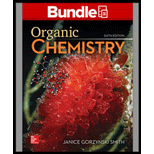
Concept explainers
(a)
Interpretation: The products formed when each triene undergoes electrocyclic reaction under
Concept introduction: Electrocyclic reactions involve the conversion of
Curved arrows aid in determining the movement and flow of electrons in the reaction. The electrons that take part in the chemical reactions are shown by the curved arrows.
(b)
Interpretation: The products formed when each triene undergoes electrocyclic reaction under
Concept introduction: Electrocyclic reactions involve the conversion of
Curved arrows aid in determining the movement and flow of electrons in the reaction. The electrons that take part in the chemical reactions are shown by the curved arrows.
Want to see the full answer?
Check out a sample textbook solution
Chapter 25 Solutions
Package: Loose Leaf For Organic Chemistry With Connect Access Card (1 Semester)
- Which alkene has the lowest heat of hydrogenation? A) H B) C) I- H D) H Harrow_forwardFor alkenes A, B, and C: (a) Rank A, B, and C in order of increasing heat of hydrogenation; (b) rank A, B, and C in order of increasing rate of reaction with H2, Pd-C; (c) draw the products formed when each alkene is treated with ozone, followed by Zn, H2O.arrow_forwardClassify each reaction as oxidation, reduction, or neither. а. b. -OH d.arrow_forward
- Which of the following alkenes undergoes disrotatory pericyclic reaction? А. heat В. OMe heat heat С. hv D. E. A and Darrow_forwarda) What is the major alkene formed when A is dehydrated with H2SO4? (b) What is the major alkene formed when A is treated with POCl3 and pyridine? Explain why the major product is different in these reactions.arrow_forwardDraw the organic products formed when cyclopentene is treated withfollowing reagent. [1] OsO4 + NMO; [2] NaHSO3, H2Oarrow_forward
- Determine the double bond stereochemistry (E or Z) for the following molecules. A а. А: Е;B В: Е b. A: Z; B: Z с. А: Е;B В: Z d. A: Z; B: Earrow_forwardRank the following alkenes from most to least stable. A. В. С. D. B.arrow_forwardElectrophilic Addition Soubong neblA-aleid rose 9160910 31 babeen ene singo 14.43 Draw the products formed when each compound is treated with one equivalent of HBr. a. b. C.arrow_forward
- Predict the oxidation product of treating the given alkene with a peroxyacid reagent. Omit byproducts. Draw the oxidation product. H. Harrow_forwardWhat is the major alkene formed when A is treated with POCl3 andpyridine? Explain why the major product is different in these reactions.arrow_forwardDraw the alkene that would react with the reagent given to account for the product formed. ? + H₂O H₂SO4 CH3 CH3 CHCCH3 OH CH3 • You do not have to consider stereochemistry. • You do not have to explicitly draw H atoms. • In cases where there is more than one answer, just draw one. Sn [F ChemDoodlearrow_forward
 Chemistry for Today: General, Organic, and Bioche...ChemistryISBN:9781305960060Author:Spencer L. Seager, Michael R. Slabaugh, Maren S. HansenPublisher:Cengage Learning
Chemistry for Today: General, Organic, and Bioche...ChemistryISBN:9781305960060Author:Spencer L. Seager, Michael R. Slabaugh, Maren S. HansenPublisher:Cengage Learning
